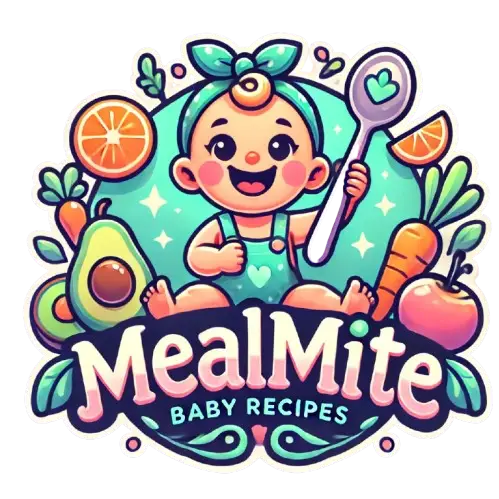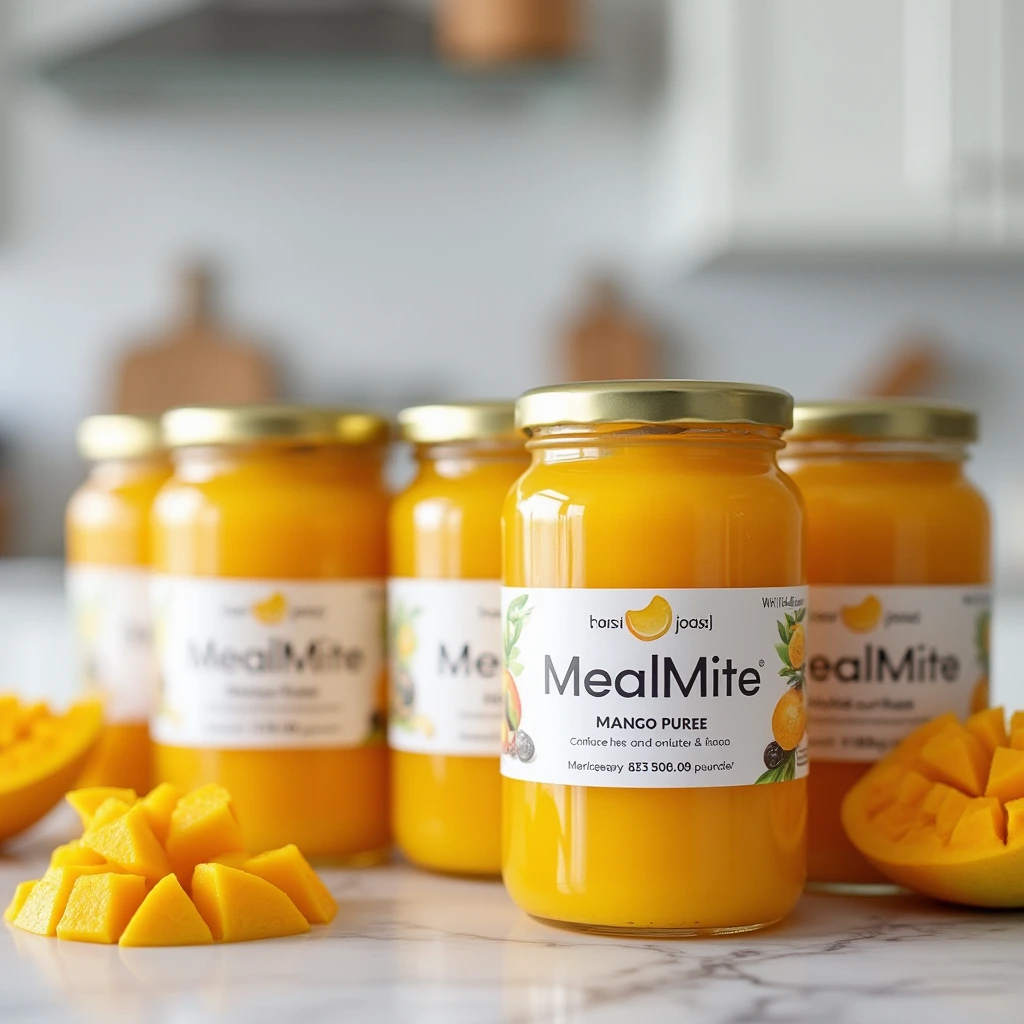Table of Contents
A surprising 69 shares on a post related to mango puree recipe for babies shows growing interest. Mango puree is a tasty way to add tropical flavors to your baby’s meals. It’s sweet and creamy, perfect for little ones.
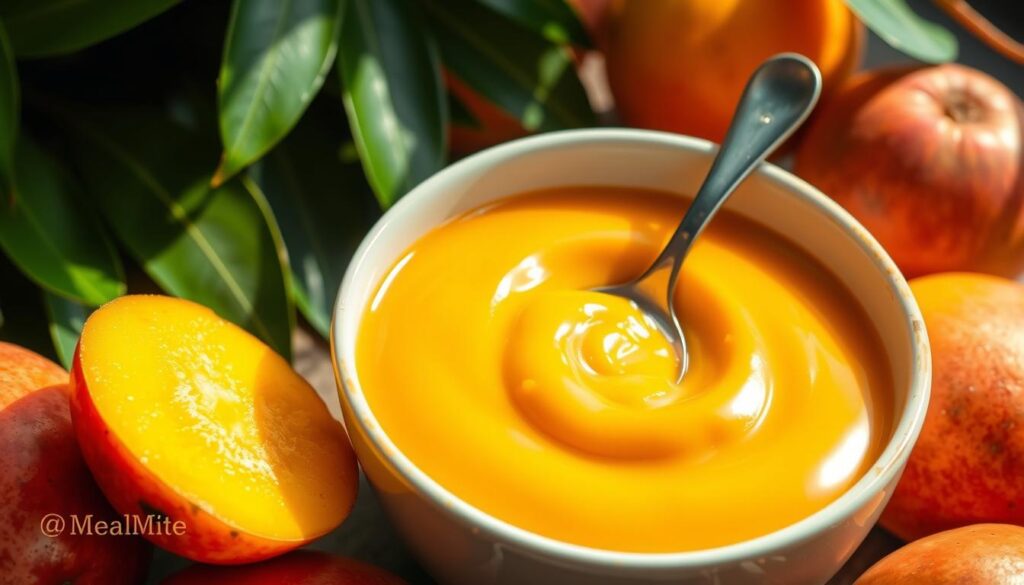
Choosing organic mango puree or making it yourself is a smart move. It lets you control what goes into your baby’s food. You can mix mango puree with foods like avocado, black beans, pineapple, and coconut milk. This makes it a nutritious and fun choice for babies.
Key Takeaways
- Mango puree is a great way to introduce tropical flavors to your baby’s diet
- Homemade mango puree can be made using fresh and organic ingredients
- Organic mango puree is a great option for ensuring your baby’s safety
- Mango puree can be paired with a variety of foods for added nutrition
- Always consult a pediatrician before introducing new foods to babies
- Mango puree can be stored in the fridge for up to 5 days or frozen in cubes for up to 2 months
Understanding the Benefits of Mango Puree for Babies
Mango puree is a great food for babies. It’s full of vitamins A and C, potassium, and fiber. Just 3/4 cup of mango gives 50% of the Daily Value for vitamin C.
It’s good to start mango puree when babies are about 6 months old. Mangoes help with constipation because they have lots of fiber. To make it, peel, chop, and blend fresh mango.
- 15% of the DV for copper in 3/4 cup of sliced mango
- 15% of the DV for folate in 3/4 cup of sliced mango
- 8% of the DV for vitamin A in 3/4 cup of sliced mango
- 2 grams of fiber in 3/4 cup of sliced mango
Start with 1 tablespoon of mango puree a day for babies over 6 months. Increase to 2-3 tablespoons by 9 months. You can keep it in the fridge for 48 hours or freeze it for 3 months. Mango puree is a tasty and healthy choice for babies.
| Nutrient | Amount in 3/4 cup sliced mango |
|---|---|
| Vitamin C | 50% DV |
| Copper | 15% DV |
| Folate | 15% DV |
| Vitamin A | 8% DV |
| Fiber | 2 grams |
Selecting the Perfect Mango Puree Recipe
To make the best mango puree, picking ripe and fresh mangoes is key. The mangoes’ quality greatly impacts the puree’s taste and texture. Look for a sweet smell, soft feel, and bright yellow or orange color.
Top mangoes for puree come from Hawaii, Florida, and California. These places are famous for their high-quality mangoes. India and Thailand also love mangoes, with India having many varieties like the Alphonso.
When picking mangoes, consider these points:
- Color: A vibrant yellow or orange color means they’re ripe.
- Texture: Softness is best for puree.
- Aroma: A sweet smell shows they’re fresh and ripe.
Choosing the right mangoes makes a delicious, healthy puree your baby will enjoy. Always pick fresh, ripe mangoes for the best taste and texture.
Mangoes come in over 1,000 varieties, some without fibers, ideal for puree. With practice, you’ll pick the perfect mangoes for your puree. Enjoy the best mango puree with your baby.
Essential Tools and Equipment for Making Mango Puree
To make mango puree, you’ll need some key tools and equipment. The right tools make the process smoother and faster. For how to make mango puree, a blender or food processor is crucial. They puree the mango to the perfect consistency.
You’ll also need a sharp knife, a cutting board, measuring spoons, and a spoon. These are vital for scooping the puree into containers. When making mango puree for a baby, using clean, sanitized equipment is a must. It ensures the puree is safe for your little one.
Consider getting some optional equipment too. A freezer-safe container or an ice cube tray can be handy. With the right tools and equipment, making delicious, healthy mango puree for babies is easy and quick.
| Tool/Equipment | Description |
|---|---|
| Blender or Food Processor | Prepare the mango for pureeing |
| Sharp Knife and Cutting Board | Prepares the mango for pureeing |
| Measuring Spoons | Measures the ingredients accurately |
How to Make Fresh Mango Puree Step by Step
To make a tasty mango puree, you need a few simple things. It’s easy to make and takes less than 5 minutes to prepare. You can use fresh or frozen mangoes, but ripe ones are best for sweetness.
The recipe uses 3 ripe mangoes, making about 6 servings. First, wash and peel the mangoes, then chop them small. Use a food processor or blender to puree them. Straining the mango pulp through a mesh sieve makes it smoother. You can also add honey or maple syrup for sweetness.
Here are the basic steps to make fresh mango puree:
- Wash and peel the mangoes
- Chop the mangoes into small pieces
- Puree the mangoes in a food processor or blender
- Strain the mango pulp through a mesh sieve for a smoother consistency
The mango puree can be stored in a glass jar in the fridge for up to 3 days. Or, freeze it in smaller portions for up to 3 months. It’s great for fruit toppings, frozen treats, baked goods, sauces, and drinks.
Safety Tips and Precautions When Preparing Baby Food
When making mango puree for babies, keeping baby food safety top of mind is key. The American Academy of Pediatric Nutrition Handbook advises against adding salt or sugar to a baby’s food. This is for their health.
To keep baby food safe, introduce solid foods one at a time. Don’t let prepared pureed baby food sit at room temperature for more than 2 hours. You can store it in the fridge for up to 2 days or freeze it for 3 to 4 months.
Kitchen Hygiene Requirements
A clean kitchen is crucial for making mango puree for a baby. Always wash your hands before cooking. Make sure to clean and sanitize all utensils and equipment. And, always store food in airtight containers.
Food Safety Guidelines
When making baby food, follow these food safety guidelines closely. Cook meats to the right internal temperature. Reheat leftovers to 165° F. And, avoid giving high-nitrate veggies like beets and spinach to babies under six months.
Common Mistakes to Avoid
Here are some common mistakes to avoid when making mango puree:
- Not washing hands before handling food
- Not cleaning and sanitizing utensils and equipment
- Not storing food in airtight containers
- Not cooking meats to the recommended internal temperature
- Not reheating leftovers to 165° F internally
| Food | Storage Guidelines |
|---|---|
| Mango Puree | Refrigerate for up to 2 days or freeze for 3-4 months |
| Meat | Use within 24 hours if stored in the refrigerator |
| Leftovers | Reheat to 165° F internally before serving |
Storage Methods and Shelf Life of Mango Puree
Proper mango puree storage is key to keeping it fresh and safe. You can store it in the fridge or freezer for later use. For a short time, keep it in an airtight container in the fridge. It will last 3-5 days.
Freezing is best for a longer mango puree shelf life. Freeze it in ice cube trays for easy use. Brands like Shimla Hills can keep it fresh for up to 24 months. This is thanks to hot filling and aseptic packaging.
Here are some tips for storing mango puree:
- Use airtight containers to prevent contamination and spoilage.
- Label and date the containers for easy identification.
- Store the puree in the freezer at 0°F (-18°C) or below.
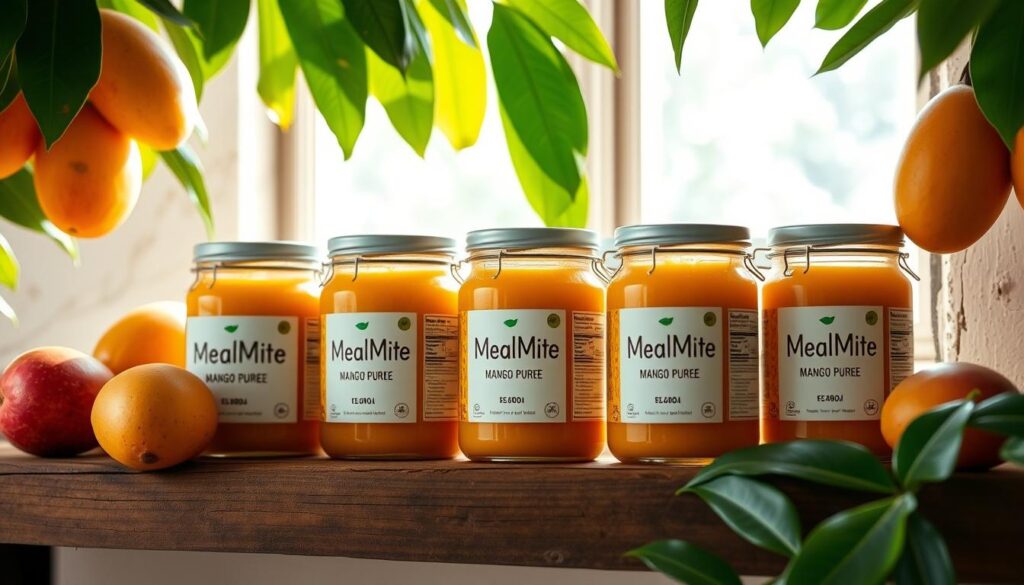
By following these tips, you can enjoy your mango puree for longer. It will stay fresh and safe.
Creative Ways to Serve Mango Puree to Your Baby
Introducing mango puree to your baby’s diet can make mealtime fun and engaging. There are many ways to serve it, ensuring your baby gets the nutrients they need. Mango puree is a great choice for baby food, packed with vitamins and minerals.
Adjust the texture of mango puree based on your baby’s age. For younger ones, mix it with breast milk or formula to thin it out. As your baby gets older, you can make it thicker and add new flavors.
Combination Ideas with Other Foods
Mixing mango puree with other foods can make for tasty and healthy meals. Here are some ideas:
- Mango and banana for a creamy and sweet treat
- Mango and oatmeal for a filling and nutritious breakfast
- Mango and yogurt for a tangy and refreshing snack
These combinations can add variety to your baby’s diet. They make mealtime exciting and introduce new tastes and textures. Always check with your pediatrician before trying new foods.
Being creative with mango puree can offer your baby a variety of healthy meals. Whether you’re looking for simple recipes or more complex ones, mango puree is a fantastic choice for baby food.
Organic vs. Conventional Mangoes for Baby Food
Parents often wonder if they should choose organic or conventional mangoes for baby food. The main worry with conventional mangoes is pesticides, which can harm babies. Organic mango puree, on the other hand, is grown without these harmful chemicals.
Organic mangoes might cost more, but the benefits are worth it. They have less pesticide, which is safer for babies. The US Department of Agriculture says organic farming is more expensive. But, it’s better for your baby’s health.
Understanding Pesticide Concerns
Pesticides are a big worry when picking mangoes for baby food. Conventional mangoes might have pesticide residues that are bad for babies. Organic mango puree, however, is made from mangoes without these chemicals.
Cost Comparison and Benefits
The price of organic and conventional mangoes can differ. But, organic mango puree offers more benefits. It has less pesticide and more nutrients, making it a good choice for parents.
| Type of Mango | Cost | Benefits |
|---|---|---|
| Organic Mango | Higher cost | Reduced pesticide exposure, higher nutritional value |
| Conventional Mango | Lower cost | May contain pesticide residues, lower nutritional value |
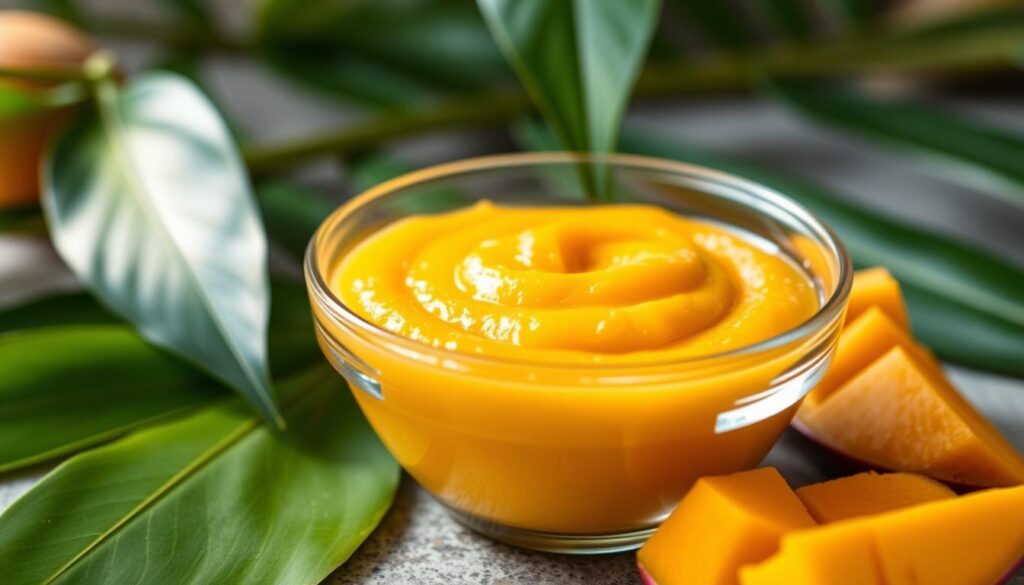
In conclusion, choosing between organic and conventional mangoes for baby food depends on several factors. While organic mango puree is pricier, its benefits are significant. It has less pesticide and more nutrients, making it a top choice for parents.
Conclusion: Embracing Homemade Mango Puree for Your Baby’s Journey
Starting your baby’s food journey with homemade mango puree is exciting. It brings vibrant flavors and important nutrients like vitamins and antioxidants. Making your mango puree ensures your baby gets the best nutrition, tailored just for them.
The perks of homemade mango puree are clear. It’s cheaper and lets you pick the ingredients. Alana found that a bag of mangoes can make many servings, saving money over store-bought jars.
Creating mango puree at home means you can keep more nutrients in and adjust the texture. This article guides you through making tasty, healthy purees that your baby will love.
FAQ
What is mango puree?
Mango puree is a smooth blend of ripe mangoes. It’s great for adding tropical flavors to your baby’s meals. It tastes sweet and feels soft, making it a hit with babies.
What are the benefits of mango puree for babies?
Mango puree is packed with vitamins, minerals, and fiber. It’s a good source of vitamins A and C, and potassium. It’s safe for babies and helps with their growth.
How do I choose the perfect mangoes for homemade puree?
Choose mangoes that are ripe, fresh, and smell sweet. They should be slightly soft and bright yellow or orange. Stay away from hard, green, or brown mangoes.
What equipment do I need to make mango puree?
You’ll need a blender or food processor and a container for freezing. Make sure to sterilize everything to keep the puree safe for your baby.
How do I make fresh mango puree at home?
Peel and pit the mangoes, then blend until smooth. This makes a creamy puree for your baby.
What safety precautions should I take when preparing mango puree for my baby?
Follow strict hygiene and safety rules. Wash your hands, sanitize equipment, and avoid mistakes that could contaminate the puree.
How do I store and preserve mango puree?
Store it in airtight containers or freezer bags. It’s best to use it within a few days. Always check for spoilage before serving.
How can I serve mango puree to my baby?
Serve it alone or mix it with oatmeal or yogurt. Adjust the thickness with breast milk or formula to match your baby’s needs.
Should I choose organic or conventional mangoes for my baby’s puree?
Both organic and conventional mangoes have their benefits. Organic might have fewer pesticides, but conventional is often cheaper. Choose based on what you prefer and can afford.
